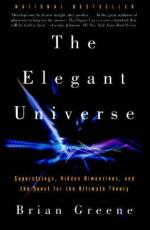
|
Chapter One, Tied Up with String
1. Two theories form the basis of modern physics, but are incompatible with one another. String theory attempts to reconcile these fields. What are these two theories?
(a) General relativity and special relativity.
(b) Quantum mechanics and the photoelectric effect.
(c) Gravity and general relativity.
(d) General relativity and quantum mechanics.
2. Who discovered the theory of general relativity?
(a) Richard Feynman.
(b) Isaac Newton.
(c) Albert Einstein.
(d) Max Planck.
3. Which of the following correctly describes the structure of an atom?
(a) A cloud of protons, each with an electron orbiting it.
(b) A cloud of electrons orbiting a dense nucleus.
(c) A single nucleus composed of both electrons and protons.
(d) A cloud of neutrons orbiting a nucleus of other particles.
4. In 1968 it was discovered that protons and neutrons are composed of which type of particle?
(a) Muons.
(b) Quarks.
(c) Baryons.
(d) Neutrinos.
5. What are the components of an atomic nucleus?
(a) Photons and electrons.
(b) Protons and electrons.
(c) Protons and neutrons.
(d) Electrons and neutrons.
(read all 180 Multiple Choice Questions and Answers)
|
This section contains 6,245 words (approx. 21 pages at 300 words per page) |

|




